You look so tired, unhappy. Bring down the government. They don’t, they don’t speak for the weekend.
Long examinations of why shitty movies suck.
Brilliant advice (thanks, R).
A shitload of good Pandemic jokes.
Dr Seuss+Dr Dre (thanks, C):
Ken Copeland’s Wind Of God:
Dying of old age
I’ve been chucking out a few 1990s gems on LinkedIn recently.
People seem to like them, but it got me thinking: Parklife is from 1997, which for the non-mathletes among you is 23 years ago.
In my advertising youth, no one was watching or applauding the ads from 23 years earlier (1973). To be honest, fifteen years earlier (1981) would have been a bit of a stretch.
Sure, we could just about recall the Pencil-winning Smash Martians, Honey Monster and Kia Ora (thanks, Mr. Webster), but no one seemed particularly interested in watching them again. And I can’t recall many discussions of Fiat Handbuilt by Robots, Lego Kipper or Benson and Hedges Iguana.
Maybe it was because they were hard to track down and inconvenient to watch, but even when they could be found more easily and viewed at the click of a mouse, they hadn’t remained a big a deal to most people in the industry.
But these are the industry equivalents of The Godfather, Barry Lyndon and The Apartment. Have they really been consigned to the mists of time?
Do people not know about them, or are they just too dated to appreciate? Do we need the context of the era and the surrounding dross to fully understand how great they were?
My take on it is that they are like 2001 or Lawrence of Arabia and Annie Hall: sought out and appreciated more by the real aficionados who appreciate the momentous steps forward that the great works gave us, but not exactly wowing the mainstream. Sure, people still seek out those movies, but 2001 can’t be as mindblowing as it was in 1968, Lawrence of Arabia existed in a time of epics where people were much more inclined to sacrifice four hours to watch a movie, and I loved Annie Hall when I first saw it, but last month I switched it off after half an hour because it seemed woefully unfunny.
I suppose it’s just a cultural case of survival of the fittest. If no one wants to seek out the D&AD winners of 1977, that’s their fault. People still want to look at a Matisse or listen to Mozart.
I’ll do what I can to keep the 1990s fire burning, but I accept that there’ll come a time when Levi’s Drugstore, Guinness Swimblack and BBC Perfect Day will be as obscure as Ali: Fear Eats The Soul (and there’s no shame in that).
Looking at the world through the sunset in your eyes. Traveling the train through clear Moroccan skies. Ducks and pigs and chickens call. Animal carpet wall to wall. American ladies five-foot tall in the weekend.
Let AI try to mash up any two songs you have links for.
Search the American Historical Photo Archive.
Have I posted this before? – Emails from an asshole.
The case for listening to new music.
Learn the proper names for your fave clichés.
Create a nation and care for/destroy its people.
10 weird Japanese movies (thanks, Y):
Better be a household name. Weather man tellin’ us it ain’t gon’ rain. So now we sittin’ in a drop-top, soaking wet, in a silk suit, tryin’ not to sweat. Hit somersaults without the weekend.
I’ve done alright up ’til now. It’s the light of day that shows me how. And when the night falls, the weekend calls.
For the second time this week I’m going to use music to point out something about advertising.
One of my favourite albums is 2001 by Dr Dre. I bought it when it came out in 1999 (man, it had been a long wait since The Chronic) and listened to it on CD. This meant I had a specific pattern of consumption: first, I rinsed Forgot about Dre. It was so damn catchy, I had to play it on a loop. Then, a week or so later, having dabbled in the other early tracks, I started to play it from the beginning: The Watcher, Fuck You, Still Dre, Big Egos, Xxplosive, What’s the Difference and Light Speed led into Forgot About Dre. Then I’d probably start again because those were all brilliant tracks, so I’d get a run of ten going with different favourites rising and falling over the months.
Then I drove to Italy with my wife, and that was one of the CDs that soundtracked the journey. So we’d listen to the whole thing, and I discovered that some of the later tracks were also brilliant (particularly Bang Bang). This made the album last for years, revealing itself in different ways, at different times and at different speeds.
Anyone my age or older will probably have their own versions of 2001 (I have several others, including Rumours, Physical Graffiti and Songs In the Key Of Life): albums that not only stayed on heavy rotation for years, but subtly transformed, like a fine wine, perhaps in response to my own changing age and emotions.
Have any ads worked on me in the same way? I mean, have they been good enough to watch again and again, possibly even improving over time?
(By the way, I know I just wrote a blog piece about scarcity being good for ads, but there are always some exceptions that prove the rule. And if anyone managed to make an ad that stood the test of a thousand viewings, hats off to them.)
If you’re my age, you saw this ad a billion times. Why was it so rewatchable? If memory serves, you could sing along with it; you could do an impression of the ‘fried onion rings’ guy; and you could wonder how ground beef could really be served ‘just like a steak’. But you could also wonder how the hell this construction-site male chorus came about. The driver’s clearly not happy about all this. And if they want chips so much, why don’t they just ask for them?
Despite featuring one of my favourite people on the planet, this ad left me cold for months. Then a strange thing happened: I grew to love it. It’s about everything and nothing; it’s about that disapproving look Thierry gives us at 00:25; and it’s about wondering if he’s supposed to be calling Robert Pires at the end.
I could have chosen dozens of kids ads – Trio, Coco Pops, Smiths Crisps, Um Bongo… any shitty food, really – but this one never gets old. What the absolute cast-iron fuck is it about? Why is Kia Ora too orangey for crows? If it is too orangey for crows, why do the crows want it so much? How does a basketball turn into a pile of laundry? As with the Dre album, over the years different crows became more and less intriguing.
What can we learn from that? Well, fiction advice suggests posing a question at the start, then refusing to answer it until the end. Oddly, though, I think these ads pose a bunch of questions and never answer any of them. They don’t really make sense, so the itch is never quite scratched, making the ads endlessly compelling.
So maybe write ads with a bit of logic and a lot of madness. That way they’ll last longer.
A Convenient Truth
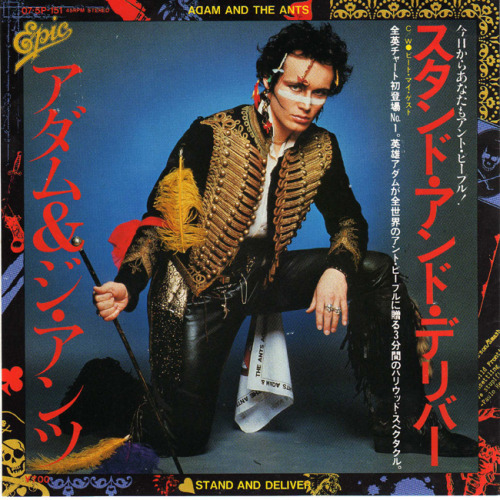
Back in the day, listening to music wasn’t easy.
Either you waited for it to appear on a radio station at the same time you happened to be listening, or you bought it, which back then was quite an expensive undertaking. I got into music as a kid in the 1980s so a fiver or tenner for an album was a lot of money. Hard decisions had to be made between the relative merits of Adam and the Ants and Culture Club.
And heaven forbid if you had heard of a something brilliant and American that hadn’t been released in the UK. If you were lucky, you could find it on ‘import’ but then it might cost three or four times the regular price.
All of that meant listening to music was not a convenient process, but it also meant I appreciated it far more. Maybe the opposite of ‘easy come, easy go’ is ‘difficult come, difficult go’, where anything you’ve worked hard to obtain gains value through being elusive.
scarcity=elusiveness=value=appreciation=happiness
Whereas
ubiquity=convenience=whatevs
But ubiquity and ‘convenience’ is where music is today. It might seem counterintuitive, but having every song in the universe in a box in your pocket has some cons to go with the pros.
Last week I downloaded the new Chidlish Gambino album. I love several of his older tracks, so as it was basically free (Apple Music) and convenient (one push of that little cloud icon), I would surely just pipe it into my ears ASAP, wouldn’t I?
Alas, I have yet to play a single note. I’m not very busy right now, so you’d think I could find an hour to give it a spin, but I just don’t care enough. It’s too ‘on a plate’. I actually prefer to get a vinyl LP off the shelf, walk over to the record player, and listen to music that way, one side at a time. Why? I don’t know for sure, but something makes me appreciate the solid object in the big, beautiful sleeve, along with the warm crackle that follows the lowering of the needle. It’s not convenient, but that’s what makes it better.
And it’s the same with movies. I like to drive twenty minutes to my favourite cinema, park the car, spend quite a lot of money on popcorn and tickets., and sit in the dark with a bunch of strangers. Yes, I could wait for the far more convenient $3.99 iTunes option, but it’s not the same. My way is somehow all the better for being more expensive, more time consuming, and much harder work.
Which brings me to advertising. In the vaguely old days, before about 2002, there was only one way to see ads: in their natural habitat of press, posters and TV channels. These all seemed kind of prestigious, as they were out of the reach of members of the public. The media seemed special, so that made the ads seem kind of special, too.
If you saw a TV ad you liked, you’d have to hope to catch it again by accident, like a song on the radio, before it disappeared completely. And it was that temporary, moment-in-time dynamic, where you either caught it or missed it, that also gave it some of the scarcity value mentioned above.
And where are we now? Ads appear for little cost on your social media feed, to be viewed forever at your convenience, at the size of a playing card, alongside people’s holiday snaps and cat videos.
We now have online previews of Superbowl ads during the week before the game, and Best Ads On TV and The Drum might be the first place you see that expensive new John Lewis ad, played on your phone as you’re walking from the tube station to the office, trying to avoid the dog poo and the traffic.
Yes, it’s convenient: it’s everywhere, it’s free and it’s endlessly repeatable. But it’s also ‘easy come, easy go’.
Sure, in the world we’ve now created, it would be perverse to return to ‘inconvenient’ viewing. But it’s worth considering how we often sell our own work short. For better or worse we’ve all been hard-wired to look down on cheap, easy things, dismissing and forgetting them in an instant. Yes, it costs less to reach many more people in the blink of an eye, but everyone knows that, so there’s little difference between your ad and some kid unwrapping presents on YouTube.
We’ve willingly dragged something elusive down to the level of any old thing, and that’s now how much of advertising comes across. The public doesn’t respect what we do because we don’t either.
The funny thing is, we’re supposed to be experts in communication. Why, then, do we seem to be so unaware of the ways in which we practice that discipline so poorly?
Woman, your fine ointment, brand new and expensive, could have been saved for the weekend.
Vegas during the C********s (thanks, T).
Corona toilet paper calculator (thanks, J).
Remember the Smash Hits poll winners of 1987?
How the C********s hit UK cinema (thanks, A).
The making of Animal House. and Full Metal Jacket.
Concatenation (thanks, Y).
Creativity in the time of Cholera.
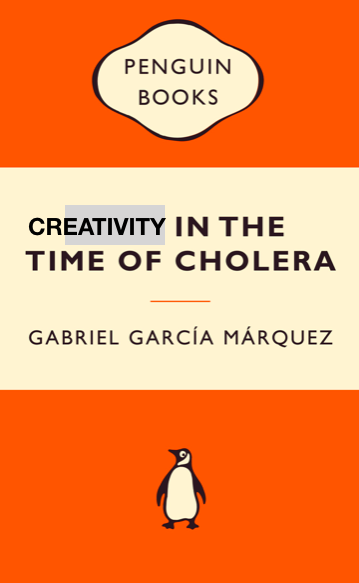
I’ve never read that book. It looks a bit long. Is it long? I get it confused with À la recherche du temps perdu, which I’ve also managed not to read. I think that’s a real doorstep. I’m not averse to a doorstep (I’ve read War and Peace), but I do like to discover that a real classic is nice and slim (see Catcher in the Rye and The Prince for excellent examples).
Anyway, here we are in the time of cholera. Depending on your country of residence, a couple of weeks of shutdown have passed. People have told you this is the new normal enough times for it to be the new normal of the new normal. You might have more work to do, but you probably have less, and you might have none. So what to do with the free time that isn’t taken up by your one mandatory exercise hour and your weekly search for toilet paper?
I used to ECD an agency whose work came in quite distinct waves. Three or four times a year we’d be a month or two of all hands to the pump, followed by a month or two of pretty much nothing. One of my art directors asked me what he was supposed to do with all this free time. I was surprised at this question because I thought all creatives had a side thing (not ‘hustle’. Never hustle. That implies some sort of part-time job whose existence is made necessary by your relatively paltry wages and the fact that your day job offers no creative satisfaction. If that’s your thing, feel free to get hustling, then enter whatever you’re doing into D&AD’s fucking stupid ‘Side Hustle’ category, but know that winning that Pencil is about as admirable as drinking a pint of your own piss).
My side thing has always been other writing. I’ve had one novel published, but I’ve written a couple more, along with three screenplays and an entire 10-episode TV series. So when my department was in a fallow time, I always had somewhere to point my creativity.
Being an advertising creative is necessarily a job of peaks and troughs. Even if you have the best, trickiest, most fascinating brief on your desk, you need time away from it, time to allow your subconscious to come up with some solutions. Maybe you could take that mental holiday by going for a walk. I found another 500 words on my other thing was just as effective. At the end of the year I tended to have most of a book finished, and it kept my writing muscle in tip-top shape.
But here we are in the time of cholera, where you might be feeling a bit adrift. Should you be battering down the doors of recruiters? Maybe, but there’s less work out there, and only so many people to contact, so at some point you’re going to have to step away from LinkedIn and do something else.
What about recharging the batteries? Slam down Tiger King, or whatever movie you’ve always been meaning to watch. Read that biography of Elton John. Make the bestest-ever workout playlist for your iPhone.
But you’ll still have plenty of free time, and here’s the real kicker: it’s a gift you may never receive again (although I’m pretty sure we’re going to go through another pandemic in the next 5-10 years). Don’t let it go to waste.
Let me give you an example: I am a poor visual artist. My drawings haven’t really moved on from when I was about twelve, and they were pretty mediocre back then. But in November I had a brainwave inspired by listening to an excellent interview with Grayson Perry, a book written by Mark Denton, and a kind email from my former creative teammate Adam Tucker: my art was my writing. No artist has really used a lot of writing as their visual (feel free to correct me, but I have yet to find one. I think if you’re good as creating pictures you’re probably not so keen on writing shitloads of words), so if I wrote and wrote and wrote, those words might look good on a single canvas or sheet of paper.
I started with large A2-ish sheets, and experimented with different colours and patterns, then I established that a single block of black type looked best, so I added that to a T-shirt and a larger canvas:
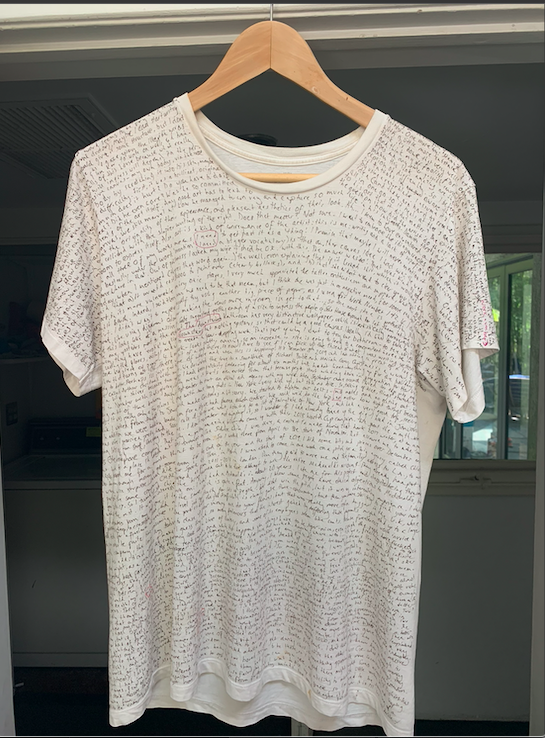
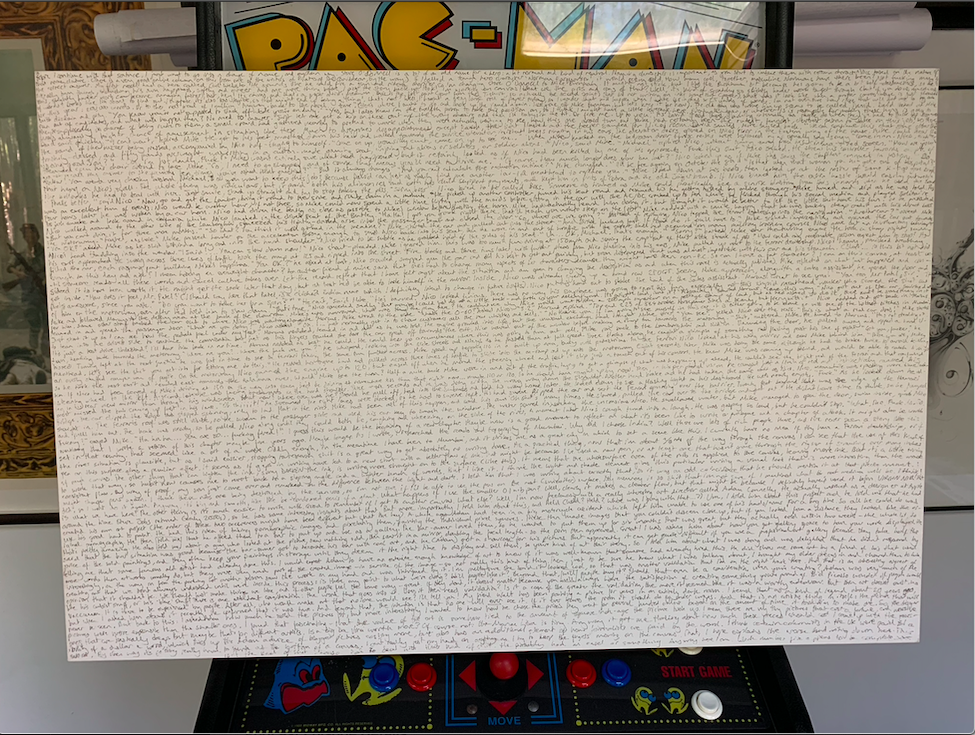
I liked the way they looked, so I took the next natural step and bought a roll of paper that’s 4 feet wide by 75 feet long. Yes, that is indeed 300 square feet. When I started it in late January I worked out that, at around 1000 words a day, it would take me until September to finish it.
As Percy once said in Blackadder 2, I like a challenge.
Every evening I knelt behind the couch as my family watched Schitt’s Creek, and added to the piece. By the end of February it looked like this:


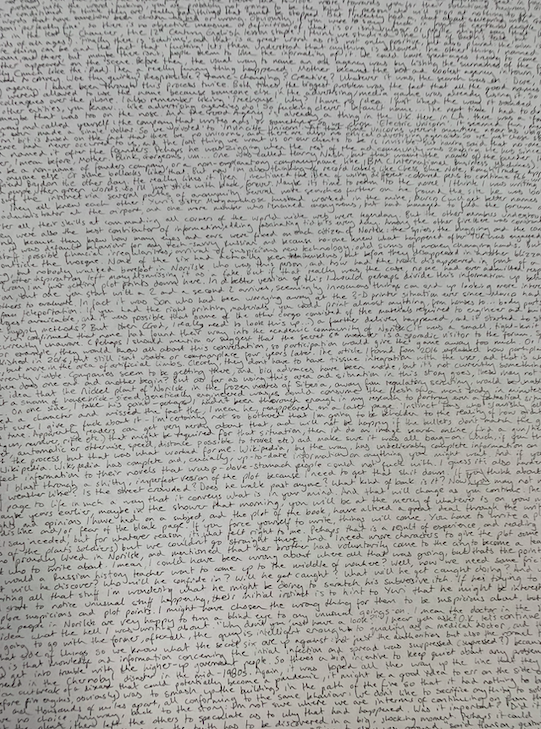
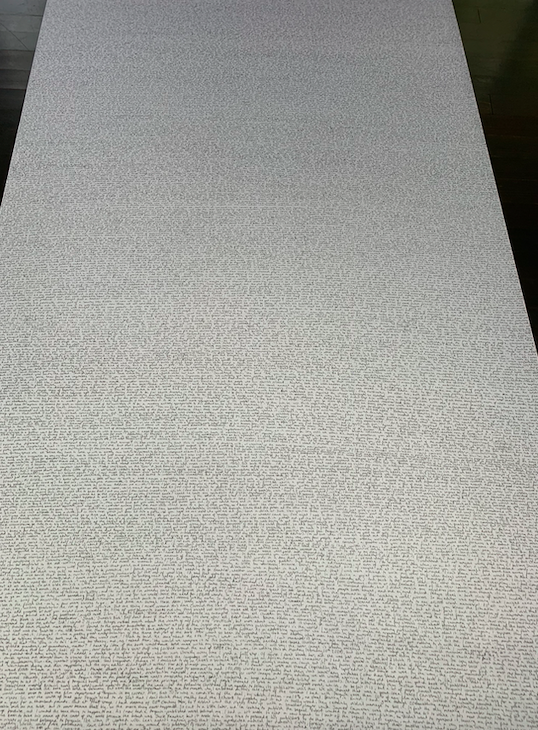

See? Kind of cool. Writing novels has given me a stoical perspective on writing lots of words, so I found the idea of 350,000 entirely doable.
When I tell people about this the first question tends to be, ‘What do you write about?’. Well, it’s a mixture of things. Most of it is the beginning of another book. I figured any novel would require several redrafts, so if I could work out a few plot and character points on here, I’d be good to go for a second draft on the computer. Otherwise I broke the fourth wall a lot and wrote about writing, or whatever was in the news, or whatever sprung to mind. It came out to about 1000 words an hour of brain-dump/novel/etc., and I soon upped my speed to 5 inches (down the page) per day, which was around 1500 words.
I had no idea what would happen to it. I thought a gallery might like it, although it would be impossible to hang or frame, so that might be problematic, but y’know, the Turbine Hall of Tate Modern might have the space. Would a gallery want it? That was the next question. I clearly have no name or standing as an artist, but is that what acceptance of ‘art’ is based on, and what is art anyway? It’s whatever the fuck I say it is, that’s what.
Then, in February, I remembered that Mark Denton had shown his work in the Royal Academy’s Summer Exhibition, which accepts submissions from professionals and first-timers alike. So I asked Mark about the process and he pointed me to the website. Luckily I was about two days away from the deadline, so I sent in the big piece as it stood (around 10ft x 4ft, or 40 square feet) and accidentally added another entry, so I also put in the canvas one shown above.
Long story short, the canvas one was shortlisted! That was pretty cool. There was some confusion on my part over which of the two pieces they’d chosen, but for whatever reason they liked the smaller one. Now I have to see if the exhibition is actually going ahead. You see, there’s this virus going around, and it’s shut all the art galleries. But I’ll happily take a shortlisting for what is literally my fifth deliberate piece of visual art.
So what I’m taking a very long time to say is that you can fill your time with all sorts of creative pursuits, even ones that aren’t your usual métier. If a non-artist like me can create something that gets shortlisted by the Royal Academy, you can probably set your dreams pretty high.
Use the time to add another quiver to your bow. You never know where it might lead, or what it might turn you into by the time this is all over. Make music with Garageband and Soundcloud; start a blog/novel/anthology of short stories on your Mac; create art out of your Amazon delivery boxes…
My current thing is stand-up comedy classes (they’ve moved online). This week is one-liners: There was a fire at the waxworks. Now they just have 73 versions of the Elephant Man.
Still got a way to go, but it feels good being on another journey.
Archives